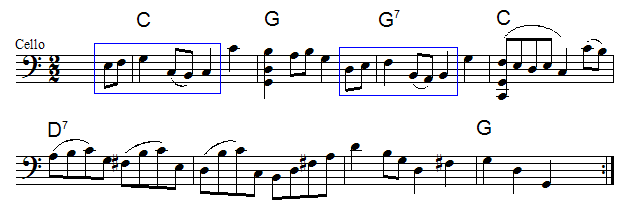Phrasing deals with the natural grouping of notes into contextual patterns that often reflect implied harmony. Although we shall not attempt a rigorous analysis of phrasing, We can develop some intuition for this relation.
We examine the first eight measures of the Bourree I from Bach's Cello Suite No. 3. The chord symbols have been added for reference.

First we examine the eight-measure pattern.
| Short (2 measures) | Short (2 measures) | Long (4 measures) |
Next we observe a two-measure pattern.
| Short (2 beats) | Short (2 beats) | Long (4 beats) |
Finally we observe a two-beat pattern.
| Short (1 half beat) | Short (1 half beat) | Long (1 beat) |
Here is a Cantor map of the first sixteen measures of the piece. The red regions represent eight beats (2 measures), the blue regions, 2 beats, and the yellow regions, half beats (eighth notes). The white regions represent the everything that is not part of the short phrase at each scale of measurement.
 |
This pattern, in fact, continues to a fourth level to the extent that the first eight measures repeat, giving us two short sections that are then followed by an extended and harmonically different 20 measure, long section.
Interestingly, although Bach wrote the piece with a repeat symbol at the end of this 20 measure section, in practice it is
often performed without the repeat.